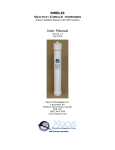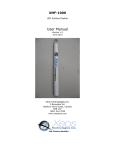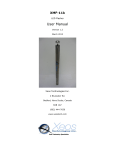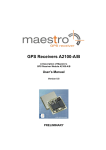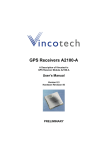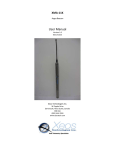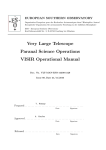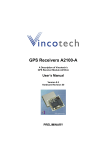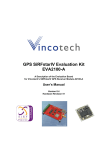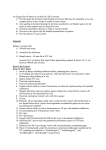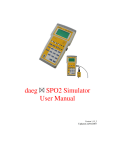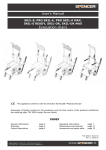Download KILO - User Manual
Transcript
KILO Iridium Satellite Beacon with GPS location User Manual Version 1.2 February 2012 Xeos Technologies Inc. 2 Bluewater Rd. Bedford, Nova Scotia, Canada B4B 1G7 (902) 444-7650 www.xeostech.com 0 SHIPPED FROM: Xeos Technologies Inc. 2 Bluewater Rd. Bedford, Nova Scotia Canada B4B 1G7 How to contact us: Email: Phone: Fax: http:// [email protected] 902-444-7650 902-444-7651 www.xeostech.com 1 Contents 1 2 3 General Description ................................................................................................................ 3 Theory of Operation ................................................................................................................ 3 Operating Instructions ............................................................................................................. 4 3.1 Setting up your Iridium Account ...................................................................................... 4 3.2 On/Off Modes and Testing ............................................................................................... 5 3.3 Communicating with the Kilo .......................................................................................... 6 3.3.1 Attaching Email Command Files .............................................................................. 6 3.3.2 RECEIVED MESSAGES ......................................................................................... 7 3.3.3 COMMANDS ........................................................................................................... 8 3.4 Tilt Sensor ...................................................................................................................... 12 3.5 Power Supply and Consumption .................................................................................... 12 3.6 Opening the Housing...................................................................................................... 12 3.7 Replacement of Batteries ............................................................................................... 13 3.8 Field Installation ............................................................................................................. 16 Appendix A - Technical Specification ........................................................................................ 17 2 1 General Description The Kilo Surface/Subsurface iridium satellite mooring location beacon continuously monitors for unplanned or accidental release of subsurface instrument moorings. Kilo makes use of the bi-directional, global, real time Iridium satellite Short Burst Data (SBD) network in combination with GPS position location. Kilo’s sleek tubular design allows it to be easily retrofitted into subsurface flotation such as syntactic foam. Inside the Kilo is a stainless steel chamber, 9602 Iridium satellite Short Burst Data core radio transceiver, a specialized low power Xeos digital controller with GPS, Iridium antenna, GPS antenna, and water sense circuitry specially designed to measure changes in capacitance. Kilo is intended for both surface and subsurface deployments. Xeos Technologies Inc. (Xeos) manufactures other specific products for either surface, or subsurface applications. See www.xeostech.com for details or call (902) 444-7650. 2 Theory of Operation The Kilo is intended for instantly and accurately locating and recovering high value, free drifting assets at sea. After being activated, the Kilo is submerged (to a maximum depth of 1000 meters), where it enters an ‘Underwater Mode’. Here, it monitors the capacitance that the water surrounding the Kilo creates for up to 1 Year. Shortly after reaching the surface, the Kilo can then report its GPS location for 90 days. Once it reaches the surface, the Kilo will enter an ‘Alarm Mode’ and send 3 consecutive messages to the iridium satellite. The first message is an iridium check. The second message is a Surfaced message. The third message contains the GPS position. The Kilo will transmit a position message every 10 minutes for 1 hour. After the 1 hour ‘Alarm Mode’, the Kilo will enter a ‘Surface Mode’ or ‘Normal Mode’, where it will transmit its position based on the timing settings. Operators can communicate with the surfaced Kilo via Iridium using email commands. Status information can be obtained, including the health of the GPS system and battery voltage. Timings are settable and should be changed within the first hour of power-up or surfacing. The default timings are 3 hours, thus the user will have to wait 3 hours for the Kilo to receive any command messages once it has entered ‘Normal Mode’. The surfaced Kilo will continue to send position messages based on the timings, until it is manually turned off, the battery pack drops below the minimum voltage requirement of 7v, or the Kilo is re-submerged. 3 3 Operating Instructions 3.1 Setting up your Iridium Account Kilo makes use of the Iridium satellite system’s (www.iridium.com) Short Burst Data (SBD) service for the 9602 transceiver. This service is a global, two-way, real-time, email-based data delivery service that has a maximum outbound (from beacon) message size of 340 bytes and a maximum inbound (to beacon) message size of 270 bytes. Kilo end users must set up an approved data delivery account with their preferred service provider. This can only be done once Xeos has provided the user with an International Mobile Equipment Identity (IMEI) number. Each 9602 has a unique IMEI number that must be registered with the preferred service provider. For a list of service providers in your area please contact Iridium for recommendations. Each IMEI number is capable of being associated with up to five (5) unique email addresses. This may vary between service providers. When registering your IMEI number, please provide the service provider with a temporary Xeos testing account email address. This account is: [email protected] This temporary email testing account can be deleted or replaced at any time after delivery of the Kilo. Once the SBD account has been activated, please contact your Xeos representative and confirm this. Kilo makes use of a simple and robust, text-based email protocol. Any email application can be used to send and receive messages to the Kilo. Command files are found on the Xeos Technologies website (www.xeostech.com), or can be emailed directly by contacting [email protected] . Once downloaded to the PC, unzip the file, which contains four (4) command files that have “.sbd” extensions used to communicate with the Kilo. You are now ready to test the Kilo beacon and prepare it for deployment. 4 3.2 On/Off Modes and Testing The Kilo beacon is turned ON and OFF through the use of an external magnet near an internal magnetic reed switch, and operation can be identified by viewing the LED through the top of the Kilo To turn the Kilo ON, begin swiping the magnet quickly up and down at the location of the reed switch. The reed switch is located directly behind the Xeos Technologies Logo. Note: if the initial color of the LED is Green that means that the Kilo is already in the on position. Swipe magnet here at location of reed switch ON/OFF Magnetic Switch Red LED = OFF A flashing green LED indicates the device is in the process of powering up, continue to swipe the magnet until you see a solid green LED. A solid green LED indicates that the device is powered and operational. Green LED = ON Note: It is important that the beacon has a good view of the sky during any test, so it is necessary to test the beacon outside of a building. To turn the Kilo OFF, repeat the above procedure with the magnet and watch the LED change from green to red. A red flashing LED indicates the device is powering down, continue to swipe the magnet until you see a solid red LED. A solid red LED indicates that the device is turned OFF. At any time the magnet can be placed against the location of the reed switch once to see which mode the beacon is currently in. A red LED indicates the device is turned OFF. A green LED indicates the device is turned ON. 5 Note: It is important to let all LEDs stop illuminating before initiating another action. Note: Cycling power for any reason, for example by using the switch to turn OFF/ON or by removing battery power, will start the Startup Alarm Mode. 3.3 Communicating with the Kilo Special email commands are used to communicate with the Kilo when it is above water. These commands are sent as email attachments. Commands can configure the Kilo before deployment and can also be used to remotely reconfigure or update status with Kilo. There are four attachment files that serve separate functions. All commands are given “over the air” and the Kilo must have a good view of the sky to receive these commands. 3.3.1 Attaching Email Command Files All command messages must be sent to the following email address: [email protected] • All messages must have only the unique IMEI number of the Kilo in the Subject line. • All command files must be sent to Kilo as an attachment to a regular email message. • Text in the body of the message will be ignored. Your message is sent to the Iridium Gateway in Arizona, USA: 6 A confirmation is immediately returned from the Gateway to let you know that your message has been received and is in the queue. This message is received from the address: [email protected] If your Kilo is above water and working, it will receive your command message the next time it does an Iridium Message Check (dependant on timings). Note: It is important to keep in mind that the “sent to” and “received from” addresses are not the same. 3.3.2 RECEIVED MESSAGES Messages received from Kilo such as GPS messages or responses to Status requests arrive as email attachments to all of the email accounts that the Kilo was setup with. When the unit is first turned on it will send out two messages (pictured below) and will enter startup mode. The first you will receive simply indicates the Firmware Version. message indicates that this is a version message. The letter ‘V’ in the The Second message is a position message. The letter ‘P’ in the message indicates that this is a position message. Time and date are displayed in UTC (05311209 would be May 31st at 12:09 UTC). The most recent GPS position obtained by the Kilo is also displayed in the position message as well as the highest GPS signal level during the most recent GPS fix (snrMx). The battery voltage is displayed in hundredths of a volt (ie. If BV = 2850, that means 28.50V on the battery). Note: It is recommended that Kilo users consider using a back-up email service (such as Gmail) as well as their primary provider. Each Kilo IMEI account can be set up by an Iridium SBD service provider usually with up to five (5) email addresses. Web-based email providers such as Gmail offer a free service and 7 plenty of memory storage to act as a backup in case your primary address is not accessible. Web-based services are also not subject to commercial or government mail server firewalls that may, at times, prevent email attachments from arriving. 3.3.3 COMMANDS There are four commands that are sent to the Kilo over the Iridium network when the Kilo is above water: 1. 2. 3. 4. SETTIMING STATUS POSITION RESET The commands are always sent as an email attachment. Command attachment files can easily be created using Notepad. Simply open a new Notepad and type in the command exactly how it is displayed in this manual. Save the Notepad with a name that corresponds to the command. Save the file’s extension name as ‘.sbd’. It is recommended that all command files are saved in one location for ease of access. Save as ‘.sbd’ 8 3.3.3.1 SETTIMING The set timing command ($SetTiming) is used to set one timer parameter in Kilo, the Iridium check and GPS acquisition. The timing value is stored in minutes. The set timing file should be set up like the file below. The default timing settings are 180 minutes (3 hours). 180 = IRD Check interval is the number of minutes between Kilo’s message checks, and GPS transmissions. The Kilo will wake up and check for messages (new instructions) at the Iridium Gateway based on this setting. These values are the default settings. When power is cycled on the beacon, the unit will return to these settings. Users can change these settings by opening the “set timing.sbd” file, changing the individual numbers (within the limits), then emailing the altered file to the Kilo as an attachment. Timer Limit: 10 to 1440 minutes (24hrs) Values set outside the limit will be ignored. The Setup command can be sent to the Iridium gateway at any time and will take effect as soon as the Kilo wakes up and connects with the Iridium Gateway. Once the Kilo receives a SetTiming command, it will change the timing configuration and send back a status message, indicating the new timing configurations. 9 3.3.3.2 STATUS The status command ($scm) is used to retrieve Kilo’s current settings and beacon status. There is no need to configure this message. The Status command message file should look like the one below. The ‘answer’ to a status request is a returned email attachment similar to this: The example above contains the following information: • 08271305 This is the date and time (UTC) in MMDDhhmm (M=Month, D= Day, h= hour, m=min). This will be the date and time of the most recent GPS fix. • S This means the message is a ‘Status Message’ • gps=3Hrs Checks the GPS position every 3 hours (this is the default). • ird=3Hrs Checks the Iridium Gateway every 3 hours (default). This is when the unit receives commands and sends messages. • lat=44.72571 Indicates GPS latitude position of unit, according to most recent GPS fix, and is expressed in decimal degrees. • lon=-63.70707 Indicates GPS longitude position of unit, according to most recent GPS fix, and is expressed in decimal degrees. There are two cases in which the user will receive a status message. If timings are changed, the user will receive a status message, and if the manual command for a status message is received from the user. 10 3.3.3.3 POSITION The position command ($GetPos) file is a request for an immediate GPS location, which is answered by the Kilo on its next Mail Message Check. The position command message should look like the one below. Once the Kilo has received a get position command, it will return a position message, like the one below. 3.3.3.4 RESET The reset command ($ResetNow) does a full software reset of the Kilo. This effectively will power OFF and ON the beacon. The unit will return to its default values of 3h. It will also start the above-water Alarm Mode. This command should only be used on the advice of Xeos Technologies Inc. The reset command file should look like the one below. 11 3.4 Tilt Sensor The Kilo comes equipped with a tilt sensor, when enabled, the Kilo will go into a hibernation state, when the device is tilted, and will return to a normal state when the device is returned to its normal orientation. The tilt axis defaults to the horizontal axis, that is, if the Kilo is standing upright, it will operate normally. If the Kilo crosses the horizontal axis, i.e. orientated upside down , it will hibernate. The tilt sensor is not enabled by default. To enable the tilt sensor one would send a message, in the same format shown above. The message should contain (without quotes) “ $switch t 1 ”. The tilt sensor will then remain enabled, even if the device is reset, until it is disabled. To disable the tilt sensor, one would send a message with the contents “ $switch t 0 ”. It is possible to use the tilt sensor on other axis (Y,Z) for more information please contact Xeos Technologies. 3.5 Power Supply and Consumption The Kilo has an internal battery enclosure that holds 12 AA batteries. The batteries should be replaced whenever the Kilo is recovered. The battery voltage can be monitored with the Status command. Typical sleep current for the Kilo is <200µA. This is the amount of current the device will draw between GPS checks and Iridium transmissions. The device has a life time of 1 Year while submerged. 3.6 Opening the Housing At the bottom of the Kilo’s acetyl housing is a screw-cap with an O-ring (568-137 70A DURO BUNA). After removing the cap, you will be able to see where the black O-ring is To replace the O-Ring, remove the Old O-ring, and clean all dirt away from the screw-cap. Apply a thin layer of O-ring lube (Parker Super ‘O’) to the new O-ring and gently slide the new O-Ring down over the threads of the screw-cap and into the O-ring groove. 12 Note: It is very important to be aware of where the O-ring is sitting on the screw cap. If the O-ring is not sitting perfectly in the O-ring groove, there will not be a perfect seal and could cause fatal damage to the unit. 3.7 Replacement of Batteries After removing the screw-cap, you will be able to see a green, circular circuit board sitting loosely inside the main body of the Kilo. Remove this board by turning the Kilo right side up and letting the board fall onto a table or your hand. After the Circuit board is removed, you will see a black battery pack with 6 slots that will hold 2 AA batteries each. (12 batteries in total) 13 Button Spring Firmware update USB port Drop the batteries into the Main body of the Kilo. At the bottom of each slot, there is either a “spring” or a “button.” For the slots with buttons, drop the batteries with the negative facing UP. For the slots with springs, drop the batteries with the positive Facing UP This is how the batteries should look when they are all inserted Slot with button Slot with spring Firmware update USB port 14 Once the batteries have been inserted, place the green circular circuit board back on top of the batteries with the springs and buttons of the board touching the batteries. Hand tighten the screw-cap back on until there is no space between the main body of the Kilo and the screw cap. The Kilo is now ready for testing, and/or deployment. NOTE: If the batteries are low, or if some of the batteries have been inserted incorrectly, the Kilo will sound a quick intermittent beep and flash the red LED at the top for 5 minutes, or until the batteries have been corrected or replaced. NOTE: The USB port located in the center of the triangle at the top of the battery pack is used for firmware updates 15 3.8 Field Installation The Kilo is intended for use on marine flotation devices. It is important that the top of the Kilo is located as high above the surface of the water as possible. Both the Iridium and GPS antennas are located at the top of the unit. It is recommended that users install Kilo on a mast or superstructure at the top of their surface buoy or flotation device. Care should be taken when installing to avoid putting metal bands close to the top of the unit where the antennas are located. 16 Appendix A - Technical Specification Mechanical: Material: Outside Housing: Derlin Case Inside Chassis: stainless steel Dimensions: 11.31” Long x 2.87” Diameter (287.5mm x 72.9mm) Weight: 2.75 kg (Air), 1.55 kg (Water) O-rings: Bottom screw-plug: 568-137 70A DURO BUNA O-Ring Lube: Parker Super ‘O’ 17 Electrical: Power Supply Battery Supply: Voltage: Capacity: Life expectancy: 12 Alkaline AA cells (user replaceable) +18 volts nominal 2.0 Amp Hours 1 Year Subsurface followed by 90 days of outbound/inbound surface messages Electronics Iridium Transceiver: Digital Controller: GPS Receiver: 9602 Xeos IRDC-3 48 channel SiRFstarIV, GSD4e GPS chip Environmental Operating Temperature: -30° C to +60° C (-22° F to +140° F) 18 Warranty, Support and Limited Liability Xeos Technologies Inc. warranties the Kilo Beacon to be free of defects in material or manufacturing for a period of one year following delivery. Liability is limited to repair or replacement of the defective part and will be done free of charge. LIMITED WARRANTY: Xeos Technologies Inc. warrants that the product will perform substantially in accordance with the accompanying written materials for a period of one year from the date of receipt. CUSTOMER REMEDIES: Xeos Technologies Inc. entire liability and your exclusive remedy shall be at Xeos Technologies Inc. option, either (a) return of the price paid or (b) repair or replacement of the product that does not meet Xeos Technologies Inc. Limited Warranty and that is returned to Xeos Technologies Inc. with a copy of your receipt. This Limited Warranty is void if failure of the product has resulted from accident, abuse, or misapplication. Any replacement product will be warranted for the remainder of the original warranty period or ninety (90) days, whichever is longer. NO OTHER WARRANTIES: Xeos Technologies Inc. disclaims all other warranties, either express or implied, including but not limited to implied warranties of merchantability and fitness for a particular purpose, with respect to the product or the accompanying written materials. This limited warranty gives you specific legal rights. You may have others, which vary from state to state. NO LIABILITY FOR CONSEQUENTIAL DAMAGES: In no event shall Xeos Technologies Inc. or its suppliers be liable for any damages whatsoever (including, without limitation, damages for loss of equipment, for loss of business profits, business interruption, loss of business information, or other pecuniary loss) arising out of the use of or inability to use this Xeos Technologies Inc. product, even if Xeos Technologies Inc. has been advised of the possibility of such damages. 19




















